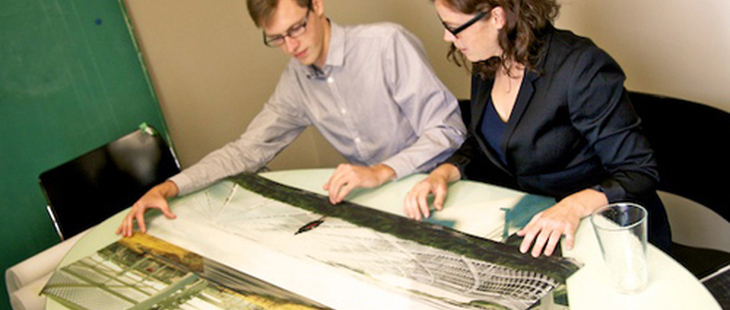
 (Tar Creek Site model (1:10000) & ground level perspective)
(Tar Creek Site model (1:10000) & ground level perspective)
A couple weeks ago, while killing time on Geoff Manaugh’s BLDGBLOG, we happened upon one of the more ambitiously outr yet bizarrely plausible plans we’ve yet seen on a site famous for specializing in “speculative architecture.” (Or maybe we’ve just read too much J.G. Ballard.) The Tar Creek Pilot Project proposes to reclaim a disused lead and zinc mine in Oklahoma, one festooned with waste rock piles as high as 13-storeys, and transform the toxic site into a massive renewable energy plant-slash-living complex.
When we discovered Tar Creek was the thesis studio project of University of Toronto graduate students Clint Langevin and Amy Norris, our interest was further piqued.
Norris and Langevin basically propose a fantastic, three-tiered superstructure: the topmost layer devoted to solar energy capture and production; the middle level for dwelling spaces; and the bottom tier as a “laboratory for bioremediation of the ground and water systems” of the severely polluted site. The whole complex would be latticed with “a connected system of boardwalks to allow inhabitants and visitors to experience both the industrial inheritance of the site and the renewed hope for its future.” The structure itself would be made pre-fab from the site’s own waste rock.
 (Clint Langevin & Amy Norris)
(Clint Langevin & Amy Norris)
Manaugh described the plan as “a bit of a Swiss Army Knife—in the sense that it tries to solve everything and have a solution for every possible challenge.”
The Standard caught up with Norris and Langevin, who collaborate under the name Captains of Industry, to talk more about the project.
Where did the idea for the Tar Creek Pilot Project come from?
AMY: We were originally going to do the thesis on the town that Clint’s from, Gouverneur, New York. It’s a town that grew with the mining operations in the area—first there was marble, then talc, zinc and iron. Now a lot of those mines have closed or are closing, having a huge impact on the area.
That was our initial focus and we visited various sites. But when we began approaching it as a thesis project we needed to have a larger-scale context and we worked on a national scale first to give an overall idea of what we wanted to accomplish.
 (View of Tar Creek Pilot Project site from blimp & Tar Creek chat pile)
(View of Tar Creek Pilot Project site from blimp & Tar Creek chat pile)
CLINT: Then we came across this amazing site in Oklahoma. Out of the five sites that we looked at in detail, it was the most horrific, I guess. Which would have been one of the reasons to avoid it. It was such an amazing site, and we knew whatever we ended up doing on the site would be more speculative, which we actually wanted to pursue. We thought it would generate more discussion than looking at one of the other sites and implementing something that’s more feasible or realistic, but might not be as interesting.
As a topic it was something I have grown up with from childhood. As a kid you don’t really realize that [an industry] is supporting the entire town. Then as you grow up, and industry starts to dwindle, you realize this is the main economic activity. So you get these huge drop-off piles of waste outside of the town that’ve become overgrown. People start to forget what built the town in the first place, and nothing has been done with these sites.
AMY: The history is lost.
The site you chose for the project is in pretty bad shape.
AMY: The Tar Creek site is covered by the Superfund Act in the US, which was created to pay for [the rehabilitation] of toxic post-industrial sites. But in this case they decided they didn’t have enough money to rehabilitate the site, so they used the money to just move people away from the site.
Now that it’s an abandoned place, you can think about how you could re-settle it. Some of the local colleges and First Nations groups are looking to re-establish a wetlands in the area and study it. But in general they are cleaning up the edges of the site and just leaving it.
 (Tar Creek Pilot Project renderings)
(Tar Creek Pilot Project renderings)
CLINT: People don’t realize how many of these toxic sites there are in the U.S. If you look at Google Earth you could probably find one from within a five-mile radius of your house….
AMY: Tar Creek is kind of like the worst case scenario, and here’s an idea for it, and how can we adapt that to work in a less extreme case.
Page 2 of 2
What’s the response been like to your thesis?
AMY: Most people have been pretty enthusiastic about it. It caused a bit of controversy with faculty, there was a lot of criticism not of the idea, but of the actual form, the radial grid basically. A lot of people immediately associate this with the Garden City or retro-ideas of urban planning. Which was funny, because that’s not where the grid idea came from, it came out of analyzing the site.
 (Tar Creek sectional model (1:150) & perspective of the structure's edge)
(Tar Creek sectional model (1:150) & perspective of the structure's edge)
During the review there were interesting discussions about frontiers for human settlement, where should new cities be built, and the idea that one could be built on these sites that to some extent have created the cities we’ve built….[and forgotten about].
CLINT: We also had some comments from people who said they wouldn’t like to live in the structure. And then there were other people that said, “Ah yeah, this would be great, I’d love to there.”
Would you live in it?
CLINT: Absolutely.
AMY: (Laughs) When we were designing it, that was definitely something we thought about. We didn’t actually design the houses per se, but rather just how they would attach to the structure. We were very conscious of where we placed them and what the views would be.
 (Perspective looking out over the solar (third) level & view from the centre of the structure towards the edge)
(Perspective looking out over the solar (third) level & view from the centre of the structure towards the edge)
What’s the benefit of this sort of speculative architecture?
AMY: I think it’s optimistic and that’s a good thing. You could look at these sites very pessimistically, because they are pretty depressing sites a lot of them. But you have to try and be optimistic, and perhaps idealistic. At least when you’re trying to envision the possibilities of what you can do with them. There is no point in limiting yourself at that point.
CLINT: Yeah, we weren’t trying to be super-specific so that we could have a proposal at the end that we could take to the government and say,” Alright, build this.” It was idealistic, but it was more to generate interest in these sites and realize their potential before you go in and do a site-specific design.
You two work together under the name “Captains of Industry”? What’s that about?
AMY: We came up with it last summer. We did a bike trip through the Adirondacks. There are a lot of towns in that area, sort of in up-state New York in general, that as we were biking through we could see a lot of factories and these pretty amazing old buildings and abandoned…
CLINT: Basically old company towns.
AMY: Right, those industrial towns that have fallen on hard times. We’ve always been interested in heritage buildings and the idea of adaptive re-use. During that bike [trip] we made the connection between those buildings and what they had meant to the town and the potential for what they could mean to those towns again. That resonated with us and we ended up incorporating that into our name. After the industrial revolution the “captains of industry” were the business leaders, the successful entrepreneurs who also contributed positively to society in some way.
 (Langevin & Norris viewing thesis renderings)
(Langevin & Norris viewing thesis renderings)
Where do you see your work together moving in the future?
AMY: We’re interested in adaptive re-use, looking at older, industrial sites; we’re interested in cross-disciplinary work, working with landscape architects and urban planners. Projects like our thesis that encapsulate a lot of our interests. We’re interested in issues of sustainability. Part of reusing these project [sites] is that you can re-use some of the material and some of the site.
CLINT: There is not really a market yet for what we call “productive reclamation” of these sites, the sort of work our thesis proposes. There being a status quo for how you repurpose an abandoned mine. Our thesis was about a new way of approaching these sites, which I think could become a niche market in the future.
AMY: I think what’s important is the role that architecture and design can have in these infrastructure and reclamation projects, because right now a lot of them are considered more as engineering projects. I think that architects and other designers can bring an overall vision and creativity to a project, which can be missing from these endeavours.
There are a lot of projects like that in Toronto, some that are hopefully happening, such as the Waterfront Project (it was important that the landscape architects leading the group were the heads of project, with a sort of creative vision, in addition to bringing together a lot of specialities, engineers, etc.) But there are so many other projects in Toronto, like the ongoing discussion about the Gardiner, in which designers should probably be involved.
 (Perspective from the public (second) level of the structure)
(Perspective from the public (second) level of the structure)
Project renderings and reference photos supplied by the architects. Photos of the architects by Raylene Knutson.














